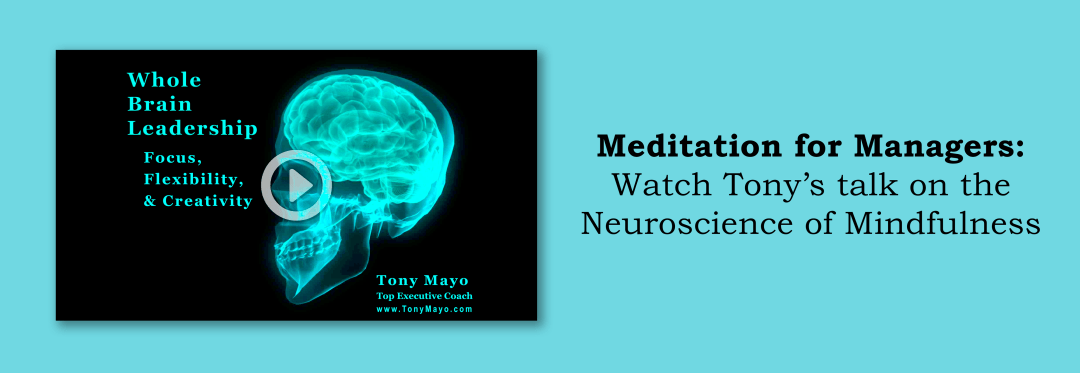by Tony Mayo | For Business Owners
 …integrating thinking and feeling is a desirable mental state, but many people have a hard time reasoning clearly when they’re upset, or bringing emotion into conceptual activities like planning.
…integrating thinking and feeling is a desirable mental state, but many people have a hard time reasoning clearly when they’re upset, or bringing emotion into conceptual activities like planning.
Researchers have recently found that the anterior cingulate cortex (ACC) is very involved with weaving thought and feeling together. They’ve also shown that the conscious control of attention is centered in the ACC, which is measurably strengthened by activities that train attention such as meditation. In another example, studies have shown that tuning into the emotional states of others–a central component of empathy–depends on the activity of the insula. The insula also handles interoception, the sensing of the internal state of the body, so mental activities such as sensory awareness activate and eventually thicken the insula, and thereby increase empathy.
In effect, investigators have found that a method used for one purpose (meditation, or sensory awareness) can stimulate and strengthen brain regions that are also involved with another purpose (integrating thinking and feeling, or empathy).
—Rick Hanson, Ph.D. is a clinical psychologist, author, and teacher with
a great interest in the intersection of psychology, neurology, and Buddhism.
He has written and taught extensively about the essential inner skills of personal well-being,psychological growth, and contemplative practice–as well as about relationships,family life, and raising children. A summa cum laude graduate of UCLA,Rick did management consulting before earning his Ph.D.
See free, easy Meditation Instructions on this blog.

by Tony Mayo | For Business Owners, For Executive Coaches
…chronically stressed rats lost their elastic rat cunning and instead fell back on familiar routines and rote responses, like compulsively pressing a bar for food pellets they had no intention of eating. … regions of the brain associated with executive decision-making and goal-directed behaviors had shriveled, while, conversely, brain sectors linked to habit formation had bloomed.
 Behaviors become habitual faster in stressed animals than in the controls, and worse, the stressed animals can’t shift back to goal-directed behaviors when that would be the better approach.
Behaviors become habitual faster in stressed animals than in the controls, and worse, the stressed animals can’t shift back to goal-directed behaviors when that would be the better approach.
I call this a vicious circle.
—Nuno Sousa, MD PhD
Life and Health Sciences
Research Institute
But with only four weeks’ vacation in a supportive setting free of bullies and Tasers, the formerly stressed rats looked just like the controls, able to innovate, discriminate and lay off the bar. Atrophied synaptic connections in the decisive regions of the prefrontal cortex resprouted, while the overgrown dendritic vines of the habit-prone sensorimotor striatum retreated.
–Brain Is a Co-Conspirator
in a Vicious Stress Loop
NYTimes.com
by Tony Mayo | For Executive Coaches
 According to the social-brain theory, it was this need to understand social dynamics–not the need to find food or navigate terrain–that spurred and rewarded the evolution of bigger and bigger primate brains.
According to the social-brain theory, it was this need to understand social dynamics–not the need to find food or navigate terrain–that spurred and rewarded the evolution of bigger and bigger primate brains.
This isn’t idle speculation; Robin Dunbar, an evolutionary psychologist and social-brain theorist, and others have documented correlations between brain size and social-group size in many primate species. The bigger an animal’s typical group size (20 or so for macaques, for instance, 50 or so for chimps), the larger the percentage of brain devoted to (more…)
…integrating thinking and feeling is a desirable mental state, but many people have a hard time reasoning clearly when they’re upset, or bringing emotion into conceptual activities like planning.


 Behaviors become habitual faster in stressed animals than in the controls, and worse, the stressed animals can’t shift back to goal-directed behaviors when that would be the better approach.
Behaviors become habitual faster in stressed animals than in the controls, and worse, the stressed animals can’t shift back to goal-directed behaviors when that would be the better approach.

Recent Comments